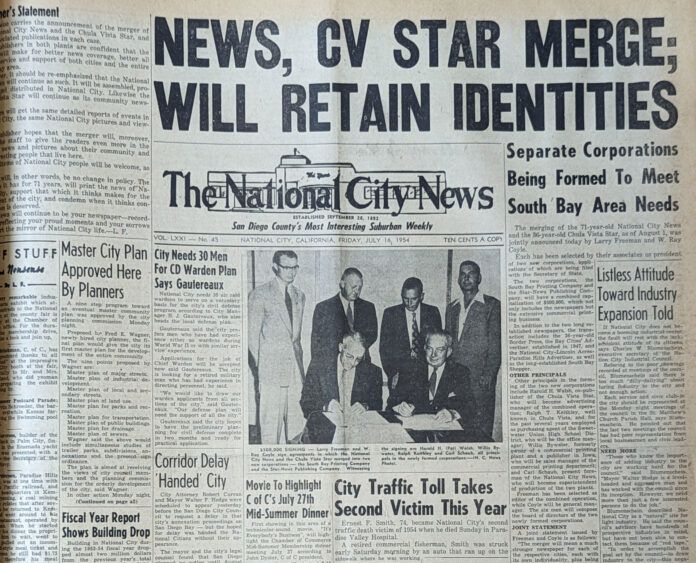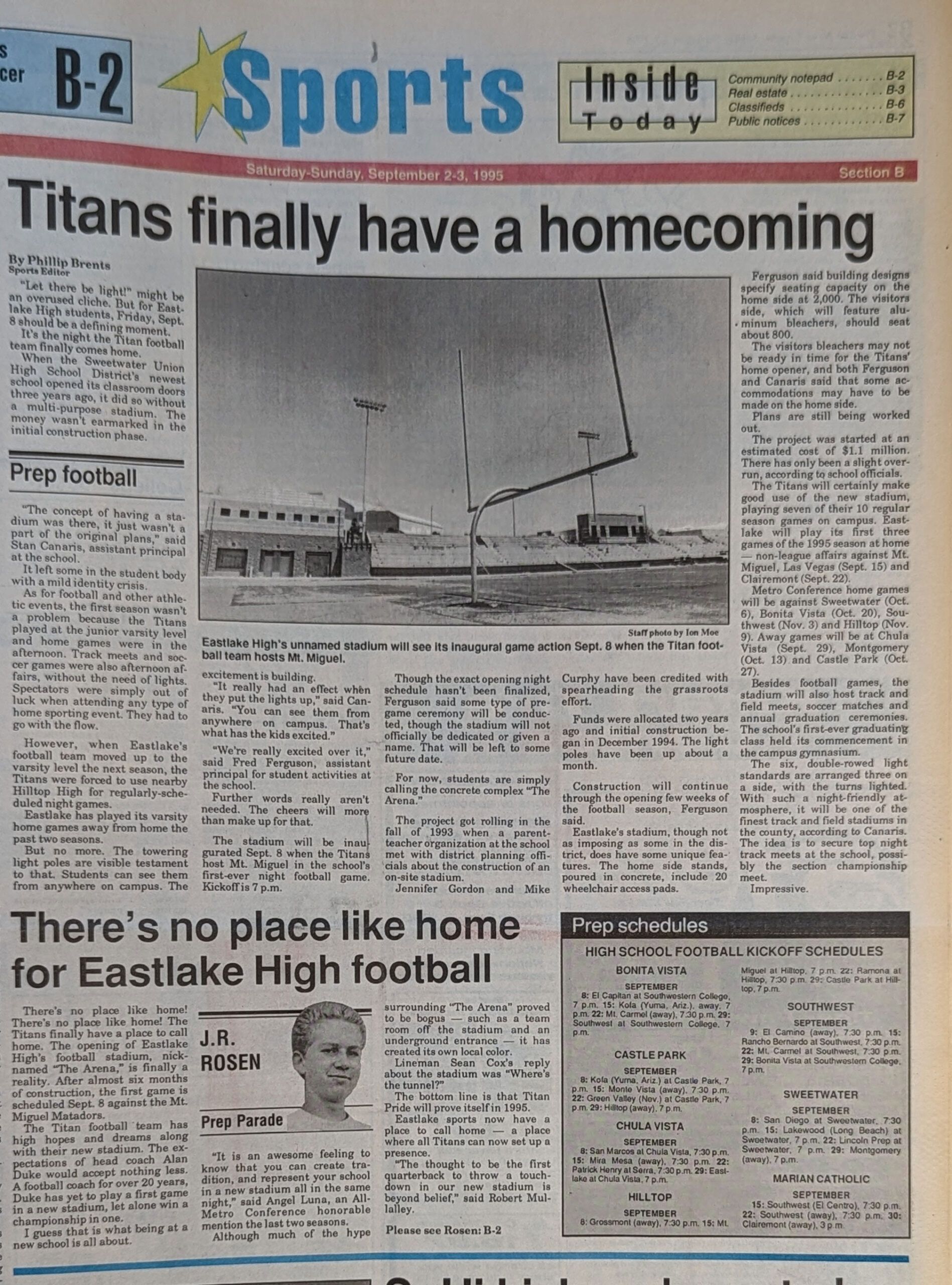
When the National City Record was first published in 1882, the first public library had recently opened in San Diego, the San Diego telephone company had just begun operations and fewer than 5,000 people lived in the entire county. Preserved newspapers clearly indicate what topics were considered newsworthy items and are a written record of local life 140 years ago.
Point Loma Nazarene University journalism program director Dean Nelson said community newspapers are a sort of campfire, “the way a community talks to itself in a way that is different from social media” with room to entertain and educate while San Diego State University journalism professor Amy Schmitz Weiss said local journalism is “more important than ever” to inform the community of what is happening around them.
Taking a regional wider view, Southwestern College journalism professor and one-time Star-News reporter Max Branscomb said the concept of a ‘paper of record’ is important as a means to record local history but today’s regional journalists must be encouraged to think broader, to look past city council and school board meetings and seek out cross-culture stories.
“It’s easy to cover the governor and the Padres but what about the people who don’t speak English and aren’t wealthy but are engines of our economy and contribute to our culture? We’re missing stories about people from Laos and Cambodia, we need people who speak Arabic in news media. We need to immerse those people in journalism so we can cover stories better,” Branscomb said.

Historically, Nelson said, there was a time when editors, politicians and developers “all patted each other on the back” and were, perhaps, less complete in their coverage than now.
“I think there’s still a need for independence from local journalism organizations so they’re not looked upon as cheerleaders for new businesses or specific politicians. That’s one of the dangers of losing credibility and becoming advocacy journalism rather than remaining neutral. When we’re perceived as being on somebody’s side, we’ve moved away from true journalism,” Nelson said.
National City Historical Society president Janice Martinelli said there is also a risk in shifting to digital publications as news can be too-easily curated— a newspaper from 100 years ago reflects everything worthy of print on any given day while a digital library sometimes houses individual articles chosen for archival at the expense of others which might prove informative in a century but will be lost to time.

A good editor, Nelson said, will point out bias and question ‘what are we doing here?’ in a news setting.
“In comparison, an everyday individual posting on Instagram or constructing Tik-Tok videos is telling people what to think and that’s not journalism,’’ Nelson said.
Ninety-five percent of internet news is “garbage”, Branscomb stated, with information gleaned from dubious sources; misinformation is the root of many problems.
“The problem is people pick and choose what to put online. If you really want to know what happened to someone, go back to news articles,” Martinelli said.
“Anybody can put anything online and make it look like it came from the Washington Post but it’s someone sitting at home posting in their pajamas. There’s a certain gravitas that happens with a newspaper, an implication that somebody else took the time to make sure they had their facts straight before they hit ‘publish’,” Nelson said and unless a reader seeks information through a newspaper’s website, there’s no guarantee it is factual.
Additionally, Martinelli said, the variety of newspapers in any given community directly reflect a diverse population.
“Think about it: we have La Prensa, Filipino Press, the Asian Journal. All these diverse people live together, work together, you can see the diversity in our region,” Martinelli said, and there is a community loss when newspapers with different viewpoints cease to exist.
Local news coverage has been “badly damaged” by consolidations in recent decades, Branscomb said, with fewer journalists and fewer resources leading to an inevitable gap in news coverage.
“For example, the U-T used to have an entire team for the South Bay area and now they have one person who can only do so much. Also, the competition between the Union and the Tribune expanded coverage in addition to the midsized papers. I think The Star-News and the Southwestern Sun have a responsibility to fill in the gaps. We’re not a news desert but we are a little bit arid,” Branscomb said.
The death of a newspaper means “fewer reporters and less coverage” Nelson said; Schmitz Weiss said those consolidations also impact how resources are allocated.
“You can see over the past several decades how much consolidation has impacted the way resources have been allotted in newsrooms across the country in terms of what is or is not covered and in some cases it can really come at the detriment to a community,” Schmitz Weiss said.
Some stories simply aren’t covered, Schmitz Weiss said, begging the question: if reporters aren’t there to gather news, who will hold people accountable for their actions?
“As a historian, I sit at the museum on the weekends and the questions teenagers are asking me make my stomach turn. They say the holocaust didn’t happen, they ask ‘what was September 11.’ It’s unreal and if I give them the facts they still don’t believe it,” Martinelli said.
Without factual knowledge, without a more informed community view, Martinelli worries people will destroy, neglect to preserve or entirely rewrite history.
“Organizations have to reflect more deeply now than ever on who is part of their community. There are invisible stories which haven’t been told in a variety of communities that dictate how media coverage fits into the status quo of the past,” Schmitz Weiss said, a way for dialogue to happen between journalist and community.
“Everything is connected: a supply chain issue here implies a problem elsewhere overseas, dictates how a connection to the global landscape is crucial,” Schmitz Weiss said, and local journalists need to look through both a local and global lens on a daily basis.
Global stories have local ramifications, Branscomb said, and San Diego’s proximity to Mexico renders “anything about the border and immigration” as a local story.
“Nobody’s going to read The Star-News to find out what’s going on in Ukraine but say there’s a group of Ukrainian refugees in Chula Vista: that’s local news with a global connection,” Nelson said and if anything, the value of a community paper is in its hyper local insight.
Community newspapers are often “the best source of info about our local government and what our elected officials are doing, how our money is being spent and they have some of the best K-12 education coverage,” Branscomb said.
“Local journalists know the culture and the population. Some of us who grew up here or have lived here a long time forget how unique our area is. Chula Vista, National City, Imperial Beach: this area is like nowhere else in the world. Ten million people cross the border every year, we influence each other and there is a blended culture. A lot of the bigger news media outlets are not able to see that,” Branscomb said.
Still, he doubts news coverage will look the same in 50 years.
“I’m intrigued by nonprofit journalism run by 501c3 orgs that could possibly be government funded. I can’t believe I’m saying that but it’s in the best interest of our society to have a healthy, ethical, well-informed news media and funding is going to have to change because I don’t think display advertising is going to carry the day anymore,” Branscomb said.
News coverage, Schmitz Weiss said, is already different from 20 years ago and the more complicated layers of technology are going to put more of an onus on reporters.
“Technology is going to dictate a more comprehensive look at individual news events but how that comes together remains a good question. Reporting will definitely be more complicated and it should be. Otherwise, robots will dictate the news if journalists don’t come in and make the story more contextual, compassionate, conclusive and accurate,” Schmitz Weiss said.
When radio first emerged, Nelson said, people predicted the end of newspapers and did so again with the invention of television and then the internet.
“The broadsheet you hold in your hand probably isn’t going to be around in the form that you know it, not in years but in decades. However, after 140 years of technological evolution, people still want to pick up the local paper,” Nelson said.
In any community, he said, the news is still the rallying point.
